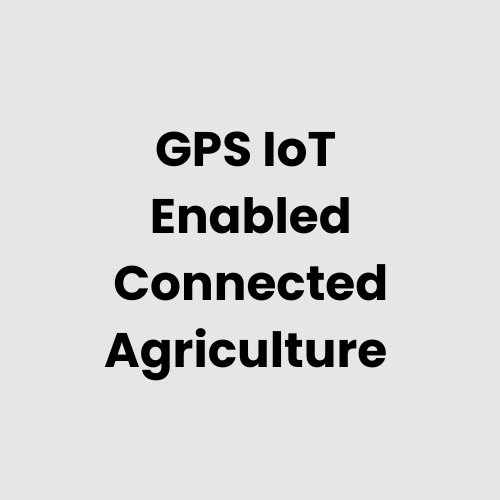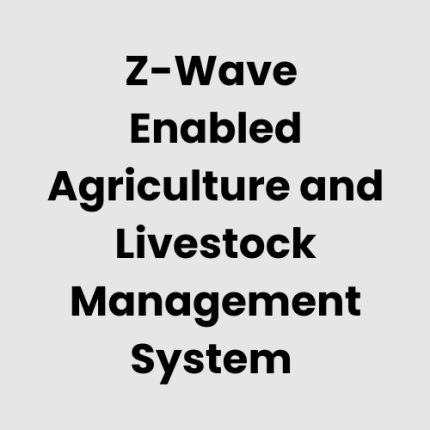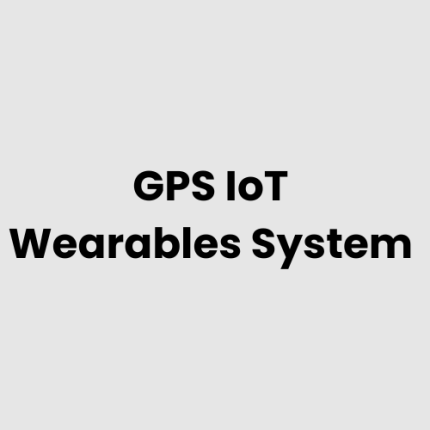Description
Technical Architecture of GPS IoT Enabled Connected Agriculture System
The GPS IoT Enabled Connected Agriculture System consists of a network of devices, sensors, and cloud platforms that work together to enhance farm productivity. The system collects real-time data from various farm elements, such as soil moisture, temperature, crop health, and equipment performance, and transmits it to a central server or cloud system for processing and analysis. Data is visualized in easy-to-read formats for farmers, enabling informed decision-making.
Components of the system include:
- IoT-enabled sensors: For monitoring soil conditions, weather, and crop health.
- GPS technology: For tracking equipment, livestock, and field conditions.
- Edge computing devices: To process data locally and reduce latency.
- Centralized Cloud Platform: For data storage, analytics, and decision support.
GAO Tek Inc. can assist in integrating this system to provide real-time monitoring, predictive analytics, and automation for agriculture operations.
List of Hardware of GPS IoT Enabled Connected Agriculture System
- IoT Sensors – Soil moisture, temperature, and pH sensors for environmental monitoring.
- GPS Tracking Devices – For tracking equipment, livestock, and crop areas.
- Drones – Used for aerial surveillance and crop health analysis.
- Edge Computing Units – Local processing units for quick data analysis.
- Weather Stations – To monitor environmental factors affecting crops.
- Wearable Devices – For tracking livestock and farm workers’ activities.
- Actuators – To automate irrigation and fertilization systems.
- Agricultural Vehicles – GPS-equipped for precision farming.
- Communication Modules – Wi-Fi, cellular, or LoRaWAN modules for data transmission.
- Power Supply Units – To support continuous operation of hardware.
GAO Tek Inc. ensures that these devices are scalable and customizable to fit the needs of modern agricultural operations.
Physical Placement Considerations of Hardware in GPS IoT Enabled Connected Agriculture System
- Sensors Placement – Position sensors at key locations within fields, such as near plant roots, or across different crop zones to get accurate environmental readings.
- GPS Units – Attach GPS devices to farm equipment, livestock, and vehicles for real-time location tracking.
- Drones – Deploy drones at optimal flight altitudes to capture aerial images of large agricultural areas.
- Weather Stations – Install weather stations on elevated areas of the farm, away from obstructions like trees or buildings, for accurate atmospheric data.
- Communication Infrastructure – Position communication hubs in central locations where they can ensure strong network coverage throughout the farm.
GAO Tek Inc. provides guidance on optimal hardware placement for maximum data accuracy and operational efficiency.
Hardware Architecture of GPS IoT Enabled Connected Agriculture System
The hardware architecture of the GPS IoT Enabled Connected Agriculture System consists of:
- Edge Devices: Local units such as gateways that receive sensor data, perform pre-processing, and send aggregated information to the central server or cloud.
- On-Site IoT Sensors: These include devices for monitoring soil conditions, weather, equipment, and livestock.
- Wireless Communication Units: Modules that allow devices to communicate with the central server via cellular, Wi-Fi, or satellite networks.
- Centralized Data Storage and Analytics Server: Where data is stored, processed, and analysed to generate actionable insights for farmers.
- User Interface Devices: Tablets or desktop systems where users can access the data visualization and make decisions based on analytics.
At GAO Tek, we specialize in designing the perfect system configuration for your specific agricultural needs, optimizing hardware for your unique requirements.
Deployment Considerations of GPS IoT Enabled Connected Agriculture System
- Scalability – The system should be scalable to accommodate farms of varying sizes, from small family-run farms to large agricultural operations.
- Data Connectivity – Ensure robust data transmission options, such as cellular, Wi-Fi, or satellite, for remote farm locations.
- System Integration – The system must seamlessly integrate with existing farm management tools and other software systems to enhance productivity.
- Battery Life and Power Management – Hardware devices should be energy-efficient, with reliable battery life to ensure long-term operation in remote locations.
- Maintenance and Support – Ensure that the system has an accessible support infrastructure for troubleshooting and regular maintenance.
- Data Privacy and Security – Implement secure data storage and transmission protocols to protect sensitive farm and business data.
At GAO Tek Inc., we provide expert deployment support, ensuring that each system is configured and deployed optimally for your agricultural operations.
List of Relevant Industry Standards and Regulations (without descriptions)
- ISO 9001 – Quality Management Systems
- ISO 14001 – Environmental Management
- ISO/IEC 27001 – Information Security Management Systems
- ANSI/TIA-4950 – Communications and IT for Smart Agriculture
- FCC Part 15 – Radio Frequency Devices
- CE Marking – Conformity with EU Standards
- IoT Cybersecurity Improvement Act – Cybersecurity standards for IoT devices
- EU GDPR – General Data Protection Regulation (for data privacy)
- FDA Regulations – For agricultural products used in food production
- ISO 17025 – General Requirements for the Competence of Testing and Calibration Laboratories
GAO Tek Inc. ensures that all our systems adhere to the relevant industry standards to provide safe and reliable solutions for our clients.
Local Server Version of GPS IoT Enabled Connected Agriculture System
The Local Server Version of the GPS IoT Enabled Connected Agriculture System allows for data processing and storage on-site rather than in the cloud. This system is ideal for areas with limited internet connectivity or for farms seeking to maintain full control over their data.
Key benefits of the local server version include:
- Reduced Latency – Real-time data analysis without relying on external servers.
- Data Privacy – Full control over sensitive agricultural data.
- Offline Operation – System continues to function even without internet access, with data synchronized once connectivity is restored.
GAO Tek Inc. offers comprehensive solutions to set up and manage local server installations for connected agriculture systems, ensuring minimal downtime and optimal data management.
Cloud Integration and Data Management for GPS IoT Enabled Connected Agriculture System
Cloud integration enables seamless communication between the farm’s devices and a centralized cloud platform, providing scalability and flexibility in data management. The GPS IoT Enabled Connected Agriculture System can transmit data from sensors and devices to the cloud, where it is analysed and stored.
Key aspects include:
- Real-Time Data Streaming – Allows for constant updates from field devices and sensors, providing up-to-the-minute data for analysis.
- Data Analytics – Powerful cloud-based analytics tools that provide actionable insights to optimize farming operations such as irrigation, crop rotation, and equipment maintenance.
- Scalable Storage – Cloud storage allows for vast amounts of agricultural data to be stored securely and accessed from anywhere.
- Remote Access – Cloud-based systems allow farmers and agronomists to monitor operations from anywhere in the world.
GAO Tek’s cloud-based solutions ensure that all data is securely transmitted, stored, and analysed to improve decision-making and maximize farm productivity.
At GAO Tek Inc., we provide end-to-end solutions for GPS IoT-enabled connected agriculture, offering both cloud and local server versions tailored to your unique needs. With decades of experience in cutting-edge technologies, we are committed to supporting agriculture’s digital transformation, providing industry-leading expertise and customer service.
GAO Case Studies of GPS IoT Enabled Connected Agriculture System
USA Case Studies
- California
A large agricultural company in California used a GPS IoT-enabled connected agriculture system to optimize irrigation and reduce water usage. The system’s real-time data on soil moisture and weather conditions helped farmers monitor irrigation schedules, leading to a 20% reduction in water consumption across thousands of acres.
- Texas
In Texas, a ranching operation integrated GPS IoT technology to track livestock and monitor pasture conditions. The system allowed farmers to monitor cattle health and grazing patterns, improving livestock management and enabling better land utilization to maximize productivity.
- Florida
A Florida-based citrus farm implemented a GPS IoT system to manage pest control more effectively. By using real-time environmental data and GPS tracking, the farm was able to deploy targeted treatments, reducing pesticide usage and minimizing environmental impact.
- Iowa
An Iowa farm adopted a GPS IoT-enabled connected system for precision planting. The system used GPS-guided tractors and sensors to optimize planting depth and spacing, resulting in higher crop yields and reduced seed wastage.
- Nebraska
In Nebraska, a large-scale corn producer deployed GPS-enabled sensors to monitor soil health and nutrient levels across different fields. With this data, the farmer was able to make precise fertilizer applications, increasing crop yield and reducing input costs.
- New York
A farm in upstate New York used a connected agriculture system to automate irrigation and crop monitoring. GPS IoT sensors provided insights into soil moisture levels and weather patterns, ensuring crops received optimal water for maximum growth and improved harvest outcomes.
- Illinois
A wheat farm in Illinois implemented a GPS IoT system to improve crop rotation management. With real-time monitoring of soil conditions and yield data, the system helped determine the best planting schedules, improving soil health and overall yield per acre.
- Michigan
In Michigan, a greenhouse operation used a GPS IoT system to monitor environmental conditions and adjust humidity levels automatically. This led to improved plant growth and reduced energy consumption by optimizing the greenhouse’s heating and cooling systems.
- Indiana
A vineyard in Indiana adopted a GPS IoT-enabled connected system to track grape ripeness and optimize harvest timing. The system provided accurate data on soil health, weather conditions, and crop growth, helping the farm achieve better wine quality with fewer resources.
- Kansas
A Kansas-based farm used GPS IoT technology to improve precision irrigation. The system integrated weather forecasting with real-time data, allowing for water conservation and ensuring crops received the precise amount of water needed at every stage of growth.
- Missouri
A Missouri farm adopted a GPS IoT system to manage fertilizer and pesticide application more efficiently. Using GPS tracking and soil data, the farm minimized chemical use while improving crop yields and ensuring compliance with environmental regulations.
- North Carolina
A tobacco farm in North Carolina utilized a connected agriculture system with GPS technology to monitor weather patterns and optimize crop protection strategies. The system enabled the farm to adjust treatments based on real-time environmental conditions, reducing costs and improving quality.
- Oregon
An Oregon farm focused on berry production incorporated GPS IoT sensors to monitor soil moisture, temperature, and crop health. The system enabled precision irrigation and real-time monitoring, helping farmers increase yields while using fewer resources.
- Ohio
A grain farm in Ohio integrated a GPS-enabled system to monitor equipment performance and reduce maintenance costs. The system tracked the usage and condition of farming machinery, providing data that helped optimize scheduling and prevent costly breakdowns.
- South Dakota
In South Dakota, a farm used a GPS IoT system to enhance livestock tracking and pasture management. The system enabled farmers to monitor the health and movements of their cattle, reducing grazing inefficiencies and improving herd management.
Canada Case Studies
- Ontario
A Canadian farm in Ontario used a GPS IoT-enabled connected agriculture system to monitor crop growth and soil conditions. The system provided data on moisture levels, allowing for precise irrigation scheduling, which reduced water usage and enhanced crop yield by 15%.
- Quebec
In Quebec, a maple syrup producer adopted a GPS IoT system for monitoring weather conditions and sap flow. By integrating real-time data, the farm optimized sap collection and syrup production processes, improving efficiency and yield during the harvest season.
Navigation Menu for GPS IoT
- GPS IoT Trackers/Devices
- GPS IoT Tracking Accessories
- GPS IoT Tracking Resources
- GPS IoT – Cloud, Server, PC & Mobile Systems
Navigation Menu for IoT
- LORAWAN
- Wi-Fi HaLow
- Z-WAVE
- BLE & RFID
- NB-IOT
- CELLULAR IOT
- GPS IOT
- IOT SENSORS
- EDGE COMPUTING
- IOT SYSTEMS
Our products are in stock and can be shipped anywhere in the continental U.S. or Canada from our local warehouse. For any further information, please fill out this form or email us.
We are actively looking for partners who are like us located in the U.S. and Canada. For more information on partnering with GAO, please visit Partner with GAO Tek Inc. It lists various ways to partner with GAO, such as OEM Partnerships, Technology Integration, Distribution and Reselling Opportunities, Presenting at the Leading Event Tek Summit, Joint R&D Projects, Training and Consulting Services, Industry-Specific Collaborations, Research and Academic Partnerships.



